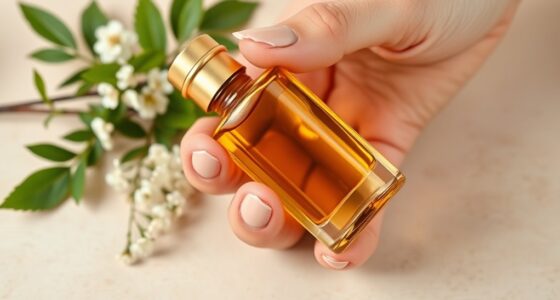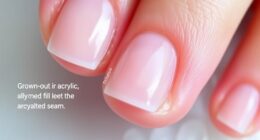Apple cider vinegar helps clear nail stains and fight fungal infections thanks to its natural antibacterial and exfoliating properties. Soaking your nails in a diluted vinegar solution can lift embedded stains and restore brightness. Its antifungal effects can also prevent and reduce fungal growth, promoting healthier nails over time. To learn effective ways to prepare and use apple cider vinegar safely and enhance your nail care routine, continue exploring helpful tips and techniques.
Key Takeaways
- Apple cider vinegar’s natural acids help lift nail stains and restore brightness with regular soaking.
- Its antifungal properties inhibit fungal growth, aiding in the treatment of nail fungus.
- Diluted vinegar soaks can prevent secondary infections by balancing nail pH and reducing microbial buildup.
- Combining vinegar with herbal infusions or gentle exfoliants enhances stain removal and fungal control.
- Consistent use over 2-4 weeks, with proper application, supports healthier, cleaner nails.
Understanding the Benefits of Apple Cider Vinegar for Nail Care
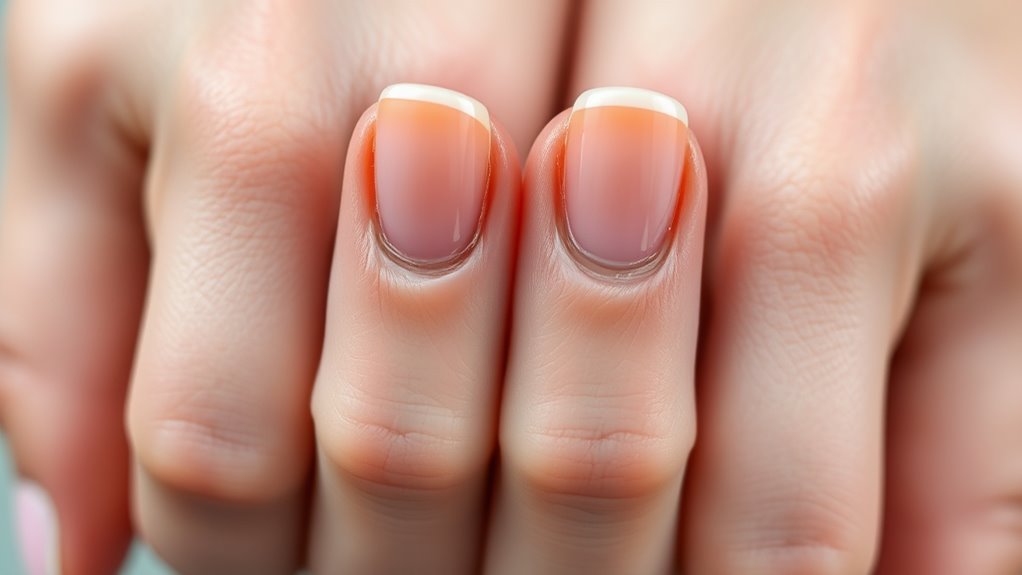
Apple cider vinegar offers several benefits for nail care, thanks to its natural antibacterial and antifungal properties. When you incorporate it into your routine, you’re supporting overall nail health by fighting off infections and preventing fungal growth. Many use natural remedies like apple cider vinegar to maintain strong, healthy nails without harsh chemicals. Its acidity helps balance the pH level around your nails, reducing the chances of fungal or bacterial buildup. Regular use can also improve the appearance of nails, making them look cleaner and healthier. Additionally, proper application techniques ensure you get the most benefit without irritation. By understanding these benefits, you can confidently include apple cider vinegar in your nail care routine as a simple, effective natural remedy that promotes nail health from the inside out.
How Apple Cider Vinegar Works Against Nail Stains

Over time, nail stains from substances like coffee, tea, or nicotine can leave your nails looking dull and discolored. Apple cider vinegar works against nail stains by helping to break down the pigments causing discoloration. Its natural acids, mainly acetic acid, gently lift and loosen stains embedded in your nail surface, making stain removal easier. When you soak your nails in a diluted apple cider vinegar solution, the acidity helps to restore your nails’ natural brightness. This process doesn’t just mask stains; it actively targets the discoloration, promoting a cleaner, more even appearance. Regular use can gradually diminish stubborn stains, revealing healthier-looking nails. Additionally, glycolic acid in skincare products is known for its exfoliating properties that can help improve overall skin texture and clarity around the nails. Keep in mind, patience is key—consistent application will give your nails a better chance at regaining their natural color.
Using Apple Cider Vinegar to Combat Fungal Infections

When you suspect a fungal infection on your nails, applying apple cider vinegar can be an effective natural remedy. Its antifungal properties help inhibit fungal growth and promote healing. To enhance fungal prevention, you can use it regularly by soaking your nails or applying it directly. Consistency is key to see results. Remember, natural remedies like apple cider vinegar work best when combined with good hygiene and dry environments. Here’s a deeper look into its benefits:
| Benefit | How it Helps | Tips for Use |
|---|---|---|
| Fungal inhibition | Stops growth of fungi | Use daily for best results |
| Antibacterial action | Prevents secondary infections | Dilute with water before use |
| Promotes healing | Aids recovery and reduces inflammation | Soak nails twice daily |
| Cost-effective | Accessible and affordable | Combine with other remedies |
| Fungal prevention | Maintains healthy nails | Maintain dry, clean nails |
Additionally, using proper application techniques can improve the effectiveness of apple cider vinegar treatments.
Preparing an Apple Cider Vinegar Nail Soak

To prepare an effective apple cider vinegar nail soak, you need to get the soaking duration and vinegar-to-water ratio right. Typically, soaking for 10 to 15 minutes works well, but avoid overdoing it to prevent skin irritation. Use a 1:1 or 1:2 vinegar-to-water mix, depending on your sensitivity and the severity of your nails’ condition. Incorporating data privacy considerations into your routine ensures your personal information remains protected during online searches.
Soaking Duration Tips
Before soaking your nails in apple cider vinegar, it’s important to determine the right duration to avoid overexposure. Overdoing it can lead to dryness or irritation, impacting nail health and nail hydration. To maximize benefits for cosmetic enhancements without risking damage, consider these tips:
- Start with 5-10 minutes to assess how your nails respond.
- Limit soaks to 15-20 minutes for regular treatments.
- Increase duration gradually if needed, but don’t exceed 30 minutes.
- Always rinse and moisturize afterward to maintain nail hydration.
- Using the correct yarn weight for nail treatments can help ensure gentle, effective results.
Consistent, appropriate soaking helps improve nail appearance and addresses issues like stains or fungus while protecting your nails’ health. Monitoring the time ensures you enjoy the benefits without risking overexposure.
Vinegar-to-Water Ratio
Achieving the right vinegar-to-water ratio is essential for a safe and effective apple cider vinegar nail soak. Proper vinegar dilution guarantees you avoid skin irritation while maximizing benefits. A common water ratio is one part apple cider vinegar to two or three parts water, but you can modify based on your skin sensitivity. If you’re new to this treatment, start with a weaker vinegar dilution—perhaps one part vinegar to four parts water—and gradually increase strength as tolerated. Always test a small area first. Remember, too much vinegar can cause dryness or irritation, so it’s better to err on the side of caution. Adjusting the water ratio helps you find a balance that cleanses and soothes without adverse effects. Additionally, understanding the benefits of apple cider vinegar can help you tailor your treatment for better results.
Step-by-Step Guide to Applying Apple Cider Vinegar for Stains

To start, you’ll need to prepare a solution by mixing apple cider vinegar with water in the right ratio. Then, apply the mixture directly to your stained nails or soak them for a few minutes. Finally, rinse and dry your nails to see the stain gradually lift.
Preparing the Solution
Creating an effective apple cider vinegar solution for stain treatment involves mixing the right proportions of vinegar and water. To prepare, follow these steps:
- Use equal parts apple cider vinegar and water for a gentle, balanced solution.
- For stubborn stains or fungus, increase the vinegar to water ratio to 2:1.
- Dip a cotton ball into the mixture, ensuring it’s saturated but not dripping.
- Avoid using pure vinegar directly on nails to protect your cuticles and prevent irritation.
This solution can also assist with nail polish removal and cuticle care, helping to loosen old polish and soften cuticle skin. Always test on a small area first to ensure your nails tolerate the mixture well before full application.
Applying and Soaking
Before applying the apple cider vinegar solution, make sure your nails are clean and dry. If you’re targeting nail discoloration, soak your nails in the solution for about 10-15 minutes. For fungal prevention, you can do this daily or every other day. Fill a small bowl with equal parts apple cider vinegar and water, or use pure vinegar for stubborn stains. Submerge your nails completely and relax during the soak. Gently scrub any stained areas with a soft brush if needed. After soaking, rinse your nails with water and dry thoroughly. Consistent application helps reduce discoloration and prevents fungal growth, promoting healthier nails over time. Remember, patience is key to seeing noticeable results.
Tips for Using Apple Cider Vinegar to Treat Nail Fungus Safely

Using apple cider vinegar safely to treat nail fungus involves following proper dilution and application techniques. First, always dilute the vinegar with water (1:1 ratio) to prevent skin irritation. Second, soak your nails for 10-15 minutes daily to promote nail strengthening and moisture retention. Third, dry your nails thoroughly afterward to avoid excess moisture that could worsen infection. Fourth, avoid overuse; limit treatments to a week or two, then reassess. Consistent use can help improve nail health while fighting fungus. Remember, maintaining proper moisture balance supports nail strengthening and prevents cracking. If irritation occurs or no improvement is seen, consult a healthcare professional. Following these tips ensures you use apple cider vinegar effectively and safely for fungal treatment.
Combining Apple Cider Vinegar With Other Natural Remedies
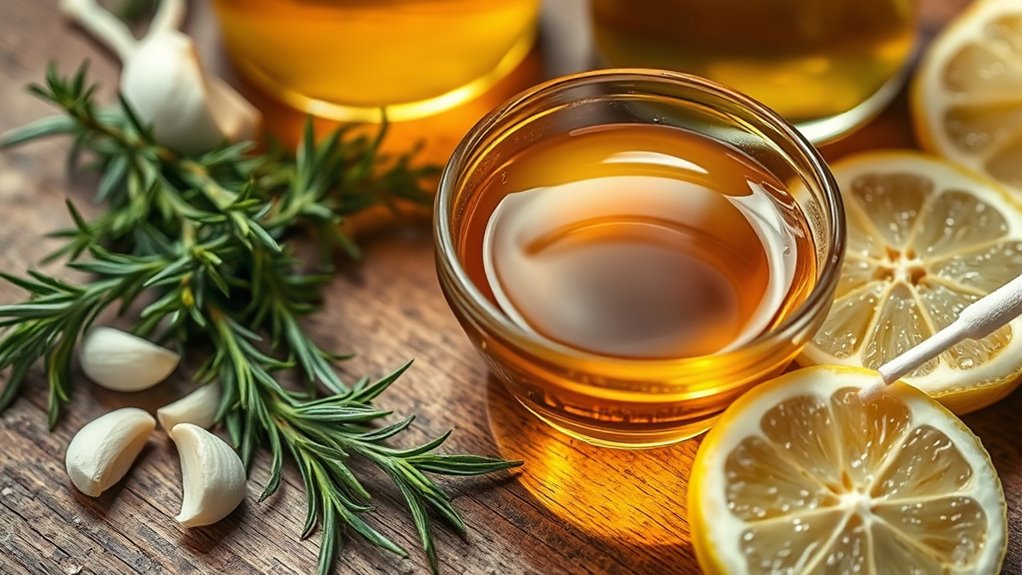
Combining apple cider vinegar with other natural remedies can enhance its effectiveness in treating nail fungus. Herbal infusions like tea tree oil or oregano oil can boost antifungal properties when added to apple cider vinegar treatments. Soaking nails in a mixture of vinegar and these oils may improve results. Additionally, natural exfoliants such as baking soda or crushed walnut shells can help remove dead skin and improve nail health. You can create a paste with apple cider vinegar and a natural exfoliant to gently scrub affected areas, promoting better absorption of the vinegar’s antifungal benefits. Always verify you’re using gentle, natural ingredients that won’t irritate your skin. Combining these remedies can accelerate healing while supporting healthy nail growth.
Precautions and Potential Side Effects of Using Apple Cider Vinegar on Nails

While mixing apple cider vinegar with other natural remedies can boost its antifungal effects, it’s important to be aware of potential side effects and precautions.
- Nail discoloration may occur if vinegar irritates the skin around your nails.
- Overuse can cause dryness or irritation, weakening your nails.
- If you have sensitive skin, apple cider vinegar might lead to allergic reactions.
- Excessive or prolonged use could hinder fungal prevention efforts, making infections worse.
- Proper skin care practices are essential to prevent adverse reactions and maintain healthy nails.
Always dilute apple cider vinegar before applying and avoid prolonged contact. Be cautious if your skin or nails become red, sore, or discolored. While it can help with fungal prevention, improper use increases the risk of damage. Consulting a dermatologist before starting treatment is recommended.
Frequency and Duration of Apple Cider Vinegar Treatments
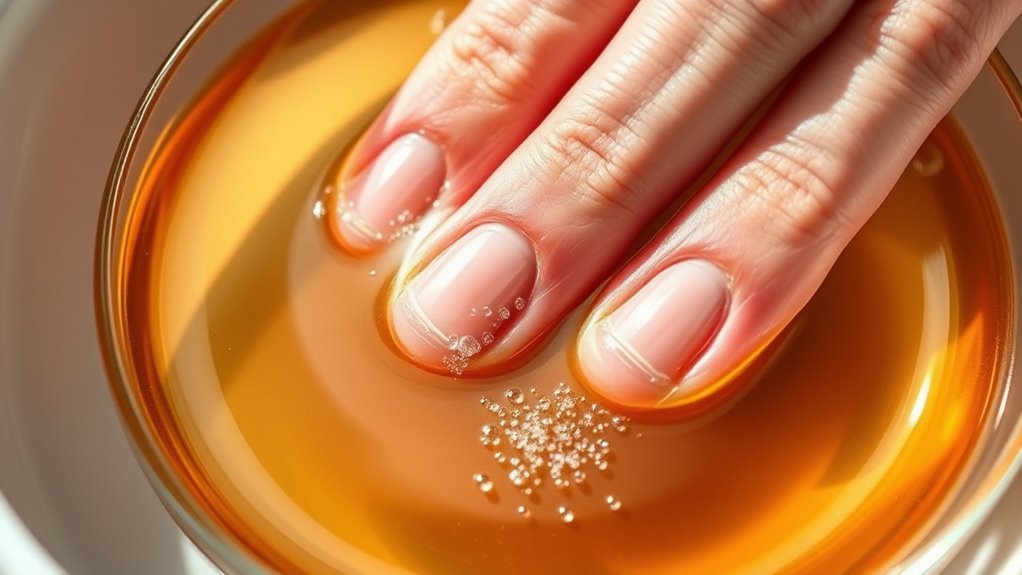
To get the best results, you need to find the right balance in how often you use apple cider vinegar on your nails. Typically, treatments are recommended a few times a week for a few weeks, but you should watch for any signs that suggest you need to adjust the frequency or duration. Paying attention to your nails’ response will help you determine what works best for your nails’ health. Incorporating local tips can also improve your treatment approach and ensure you are using the method safely.
Optimal Treatment Frequency
For safe and effective results, it’s important to establish a consistent treatment schedule when using apple cider vinegar for nails. This helps maximize nail health and cosmetic benefits without causing irritation. Typically, you should consider:
- Applying the treatment 2-3 times weekly for mild issues.
- Using it daily if dealing with persistent fungal infections.
- Limiting treatments to 2-4 weeks to avoid skin dryness or sensitivity.
- Monitoring your nails’ response and adjusting frequency accordingly.
- Incorporating dog breeds knowledge to recognize any unusual reactions or sensitivities that may require stopping or modifying treatment.
Consistency is key to seeing improvements in stain removal and fungal control. Sticking to this schedule ensures you get the best cosmetic benefits while maintaining healthy nails. Remember, overdoing it can cause irritation, so always listen to your body and modify as needed.
Recommended Duration Periods
Establishing the appropriate duration of apple cider vinegar treatments is essential for achieving safe and effective results. For nail polish removal, soaking nails in a vinegar solution for about 10-15 minutes daily can help loosen polish without damaging your nails. When it comes to cuticle care, limit soaks to 10-20 minutes, a few times a week, to soften cuticles without over-drying. Consistent application over two to three weeks typically yields noticeable improvements. Avoid prolonged or excessive treatments, as this can cause irritation or dryness. Always monitor how your nails and skin respond, and adjust the duration accordingly. Proper timing guarantees you benefit from apple cider vinegar’s properties without risking overexposure or adverse effects. Additionally, understanding how color accuracy impacts visual results can help tailor your treatment plan for better overall nail health and appearance.
Signs to Adjust Use
Monitoring how your nails and skin respond during apple cider vinegar treatments helps you determine if adjustments are necessary. Watch for signs like persistent nail discoloration or worsening fungal symptoms. If you notice any of these, consider modifying your routine. Here are key indicators to watch for:
- Increased nail discoloration or darkening
- Persistent or worsening fungal symptoms
- Skin irritation or redness around your nails
- Pain or discomfort during or after treatment
If any of these occur, reduce the frequency or duration of treatments. For example, cut back to every other day or shorten soaking time. Always listen to your body and consult a healthcare professional if symptoms persist or worsen. Adjusting your approach helps protect your nails and skin while effectively using apple cider vinegar.
Additional Tips for Maintaining Healthy Nails Naturally
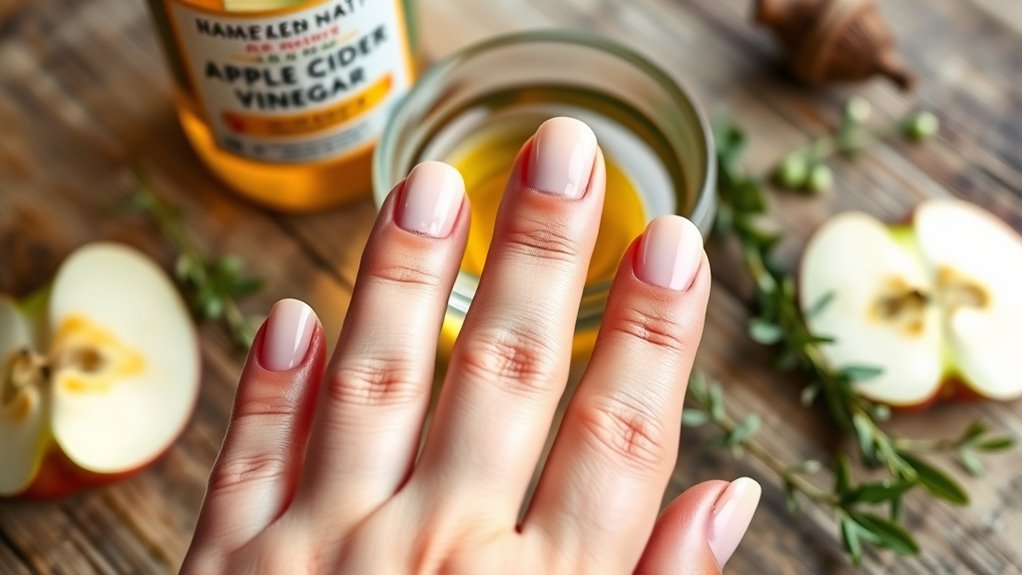
To keep your nails healthy naturally, incorporating simple lifestyle habits can make a significant difference. Focus on nail nutrition by eating a balanced diet rich in biotin, zinc, and vitamins A and E, which strengthen nails from within. Regularly moisturize your hands and cuticles to prevent dryness and cracking, using natural oils like coconut or olive oil. Avoid harsh chemicals and excessive hand washing, which can strip moisture and damage nails. Keep your nails trimmed and filed to prevent splits and breaks. Wearing gloves during chores protects nails from exposure to water and cleaning agents. Staying hydrated supports nail health and promotes growth. By maintaining good nail nutrition and hand moisturization, you help your nails stay strong, shiny, and healthy naturally.
Frequently Asked Questions
Can Apple Cider Vinegar Cause Allergic Reactions on Nails?
Yes, apple cider vinegar can cause allergic reactions on your nails if you have skin sensitivity. You might notice redness, itching, or irritation around your nails or cuticles after applying it. To avoid this, do a patch test first by applying a diluted vinegar solution to a small skin area. If you experience any allergic reactions, discontinue use immediately and consult a healthcare professional.
Is There a Specific Type of Apple Cider Vinegar Best for Nails?
Think of choosing apple cider vinegar for your nails as finding a hidden gem. You should opt for organic, unfiltered versions because they retain the natural benefits, like enzymes and beneficial acids. These types are best for nail care, helping with stains and fungus. The unfiltered benefits guarantee you’re using a product that’s pure and potent, giving your nails the gentle yet effective treatment they deserve.
How Long Should I Leave Apple Cider Vinegar on My Nails?
You should leave apple cider vinegar on your nails for about 10 to 15 minutes per application. Follow the duration guidelines to avoid irritation, and apply it 1 to 2 times daily for best results. Make sure to rinse your nails thoroughly afterward and moisturize to prevent dryness. Consistent application helps treat stains and fungus effectively, but don’t overdo it to protect your skin and nails.
Can Apple Cider Vinegar Be Used With Nail Polish?
Sure, you can try using apple cider vinegar with nail polish, but don’t expect a flawless manicure. It’s like trying to mix oil and water—you’ll face poor nail polish compatibility and unpredictable chemical interactions. Vinegar’s acidity can cause your polish to bubble or peel prematurely. So, unless you’re into DIY experiments gone wrong, it’s best to keep vinegar and nail polish apart for a smooth, lasting finish.
Are There Age Restrictions for Using Apple Cider Vinegar on Nails?
You should consider age-appropriate use of apple cider vinegar on nails, especially for children. Pediatric recommendations advise caution, as young skin can be sensitive and more prone to irritation. It’s best to consult a healthcare professional before applying apple cider vinegar to nails of children or teenagers. For adults, it’s generally safe if diluted properly, but always patch-test first to avoid any adverse reactions.
Conclusion
Using apple cider vinegar can effectively improve nail health, helping to reduce stains and fight fungal infections. Just remember, consistent use over a few weeks shows the best results. Remarkably, one study found that vinegar’s acetic acid can inhibit fungal growth in up to 80% of cases. So, with patience and proper care, you can naturally restore your nails’ strength and appearance without harsh chemicals. Stay consistent, and your nails will thank you!


